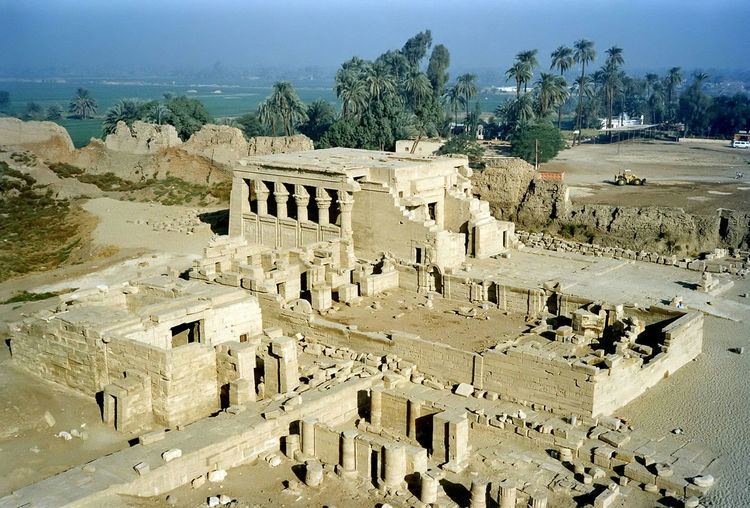Phone +20 109 507 1411 | ||
 | ||
Address Qism Qena، Dandarah, Qena, Qena Governorate, Egypt Similar Temple of Edfu, Philae, Karnak, Luxor Temple, Abu Simbel temples | ||
Dendera Temple complex, (Ancient Egyptian: Iunet or Tantere; the 19th-century English spelling in most sources, including Belzoni, was Tentyra) is located about 2.5 kilometres (1.6 mi) south-east of Dendera, Egypt. It is one of the best-preserved temple complexes in Egypt. The area was used as the sixth Nome of Upper Egypt, south of Abydos.
Contents
- Dendera temple complex egypt 2013
- Description
- Hathor temple
- Dendera zodiac
- Necropolis and crypts
- The Dendera light
- Ceiling cleaning
- Tourism
- References
Dendera temple complex egypt 2013
Description
The whole complex covers some 40,000 square meters and is surrounded by a hefty mud brick enclosed wall. Dendera was a site for chapels or shrines from the beginning of history of ancient Egypt. It seems that pharaoh Pepi I (ca. 2250 BC) built on this site and evidence exists of a temple in the eighteenth dynasty (ca 1500 BC). But the earliest extant building in the compound today is the Mammisi raised by Nectanebo II – last of the native pharaohs (360–343 BC). The features in the complex include
Hathor temple
The all overshadowing building in the Complex is the main temple, namely Hathor temple (historically, called the Temple of Tentyra). The temple has been modified on the same site starting as far back as the Middle Kingdom, and continuing right up until the time of the Roman emperor Trajan. The existing structure was built no later than the late Ptolemaic period. The temple, dedicated to Hathor, is one of the best preserved temples in all Egypt. Subsequent additions were added in Roman times.
- Large Hypostyle Hall
- Small Hypostyle Hall
- Laboratory
- Storage Magazine
- Offering Entry
- Treasury
- Exit to Well
- Access to Stairwell
- Offering Hall
- Hall of the Ennead
- Great Seat and Main Sanctuary
- Shrine of the Nome of Dendera
- Shrine of Isis
- Shrine of Sokar
- Shrine of Harsomtus
- Shrine of Hathor's Sistrum
- Shrine of gods of Lower Egypt
- Shrine of Hathor
- Shrine of the Throne of Rê
- Shrine of Rê
- Shrine of Menat collar
- Shrine of Ihy
- The Pure Place
- Court of the First Feast
- Passage
- Staircase to Roof
Depictions of Cleopatra VI which appear on temple walls are good examples Ptolemaic Egyptian art. On the rear of the temple exterior is a carving of Cleopatra VII Philopator (the popularly well known Cleopatra) and her son, Ptolemy XV Philopator Philometor Caesar (Caesarion), fathered by Julius Caesar.
Dendera zodiac
The sculptured Dendera zodiac (or Denderah zodiac) is a widely known relief found in a late Greco-Roman temple, containing images of Taurus (the bull) and the Libra (the balance). A sketch was made of it during the Napoleonic campaign in Egypt. In 1820 it was removed from the temple ceiling and is now in the Louvre. Champollion's guess that it was Ptolemaic proved correct and Egyptologists now date it to the first century BC.
Necropolis and crypts
The Dendera necropolis is a series of mastaba tombs. The necropolis dates from the Early Dynastic Period of the Old Kingdom to the First Intermediate Period of Egypt. The necropolis runs the eastern edge of the western hill and over the northern plain. The subterranean Hathor temple tombs total 12 chambers. Some reliefs are dated to as late as Ptolemy XII Neos Dionysos reign. The crypts reportedly were used for storing vessels and divine iconography. An opening in the "Flame Room" floor leads to a narrow chamber with representations on the walls of the objects which were kept in them. In the second chamber, a relief depicts Pepi I. He offers a statuette of the god Ihy to four images of Hathor. In the crypt, reached from the "Throne room", Ptolemy XII has jewelry and offerings for the gods.
The Dendera light
Hathor Temple has a relief sometimes known as the Dendera light because of a controversial fringe thesis about its nature. The Dendera light images comprise five stone reliefs (two of which contain a pair of what fringe authors refer to as lights) in the Hathor temple at the Dendera Temple complex located in Egypt. The view of Egyptologists is that the relief is a mythological depiction of a djed pillar and a lotus flower, spawning a snake within, representing aspects of Egyptian mythology.
In contrast to this interpretation, there is a fringe science suggestion that it is actually a representation of an Ancient Egyptian lightbulb.
Ceiling cleaning
The ceiling of the Hathor Temple has recently been cleaned in a careful way that removed hundreds of years of black soot without harming the ancient paint underneath. As a result of this cleaning, spectacular ceiling painting has been exposed in the main hall, and some of the most vibrant and colourful paintings dating from antiquity are now visible.
Tourism
The Dendera complex has long been one of the most tourist-accessible ancient Egyptian places of worship. It used to be possible to visit virtually every part of the complex, from the crypts to the roof. However, the highest part of the roof of Hathor temple has been closed since 2003. The second stage of the roof was closed in November 2004, after a tourist got too close to the edge and fell to her death on the bedrock below.
